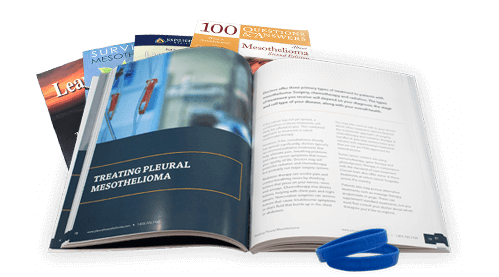Extrapleural Pneumonectomy (EPP) for Pleural Mesothelioma
Extrapleural pneumonectomy for pleural mesothelioma is a surgery that involves removal of the cancerous lung, parts of the diaphragm and nearby tissues where the cancer has spread. The procedure helps some early-stage patients outlive the average one-year prognosis.
How Does EPP Treat Pleural Mesothelioma?
The treatment goal of an extrapleural pneumonectomy for mesothelioma is removal of all visible signs of cancer and tissue that may harbor unseen cancerous cells. Even if the cancer returns, the surgery delays recurrence longer than other treatments such as chemotherapy.
While the surgery is not considered a cure, it has helped some patients live longer when combined with other mesothelioma treatments such as chemotherapy, radiation therapy and immunotherapy.
According to a 2018 study published in the European Journal of Cardio-Thoracic Surgery, the extrapleural pneumonectomy helped patients live an average of 33.2 months.
In that study, researchers showed the five-year survival rate was 24.2 percent, a significant improvement to the typical five-year survival rate of less than 10 percent.
The extrapleural pneumonectomy for mesothelioma is also known as an EPP.
Benefits of the Extrapleural Pneumonectomy
An extrapleural pneumonectomy for mesothelioma has the potential to make breathing easier and improve overall quality of life.
Because it removes the majority of the cancer, it may improve a pleural mesothelioma patient’s prognosis, especially if it’s combined with other treatments such as chemotherapy or radiation in what is known as multimodal therapy.
Some studies show patients who undergo an extrapleural pneumonectomy for mesothelioma have a longer survival rate than patients who undergo a pleurectomy and decortication.
In one study led by the late Dr. David Sugarbaker, 70 percent of patients who underwent EPP and other forms of treatment survived up to one year after diagnosis and 48 percent of patients survived at least two years after diagnosis.
Who Is Eligible?
Typically, only patients diagnosed with earlier stages of pleural mesothelioma are considered good candidates for the extrapleural pneumonectomy. About 15 to 20 percent of mesothelioma cases qualify for aggressive surgery at the time of diagnosis.
Candidates must also be in otherwise good health with a strong heart. Removal of a lung will increase the workload for the heart and the remaining lung. Doctors assess overall health and assign a performance score. A lower score indicating greater health. Candidates for surgery must have a score no higher than two.
Other tests, such as biopsies, imaging scans and others that assess lung function and heart health, define a patient’s eligibility for the EPP.
- Biopsies reveal the cell type of the tumor, and the epithelial cell type responds best to surgery.
- Imaging scans, such as a PET scan, show if the cancer has spread beyond the diaphragm or distant organs.
- Tests to assess lung function determine if the remaining lung will work well enough once the cancerous lung is removed.
- Heart tests, such as an echocardiogram, check if the heart can sustain surgery and subsequent chemotherapy.
Stages of an Extrapleural Pneumonectomy
Because an EPP is a complicated procedure, an experienced and qualified thoracic surgeon is the only medical professional who should perform it. The entire procedure takes three hours or longer.
- The patient is first given general anesthesia. The surgeon then makes a nine- to 10-inch lateral incision along the patient’s chest cavity, either in the front or on the side. The surgeon may remove the sixth rib to gain better access to the cancerous lung and to create more space for the procedure.
- The linings of the chest and heart are then separated from the chest wall and the diaphragm, and any blood vessels supplying the cancerous lung are redirected.
- Once the chest cavity is open, the surgeon inspects the area and removes all visible cancerous tissue, including the entire diseased lung, parts of the lining of the lung and heart, parts of the diaphragm, and possibly nearby lymph nodes.
- The surgeon then reconstructs the lining of the chest, heart and the diaphragm using a medical grade mesh lining. In some cases, heated intrapleural chemotherapy is used after the removal of the lung and before reconstruction to target any leftover cancerous cells. Then the incision is closed with stitches.

What to Expect After EPP Surgery
Recovery post-extrapleural pneumonectomy is extensive and may require a two-week hospital stay. Generally, the patient is on a respirator for the first couple days or longer and is hooked up to drainage tubes to minimize fluid buildup.
Because complications with this surgery are not uncommon, malignant pleural mesothelioma patients are monitored closely. A heart monitor will constantly evaluate the heart. Blood tests will check for signs of infection, elevated liver enzymes and more.
Nurses will encourage deep breathing and teach coughing techniques to prevent pneumonia. Physical therapists will help patients return to walking and using their arms. Clinical dietitians will help provide medical nutrition therapy for patients.
At-Home Recovery
Home recovery from an extrapleural pneumonectomy for pleural mesothelioma begins once the patient is discharged from the hospital. For another six to eight weeks, the patient will be focused on recovery. This includes a lot of rest as the body adjusts to using just one lung to breathe.
At-home recovery may be physically and emotionally difficult. It is important to eat a healthy diet rich in protein and nutrients. Physical therapy and pulmonary rehabilitation therapy help patients recover fully.
Multimodal Therapies
Many patients undergo radiation therapy, chemotherapy or both, five or more weeks after surgery. These treatments help to kill cancer cells left behind during surgery. This may delay cancer recurrence.
Patients who qualify for EPP generally qualify for radiation and chemotherapy. Surgery alone doesn’t extend survival as much compared to multimodal therapy. The combination of these treatments offers the greatest hope for longer survival.
New research is investigating other therapies to add to the multimodal approach. For example, clinical trials are researching immunotherapy drugs, gene therapy and photodynamic therapy.
Possible Side Effects of an Extrapleural Pneumonectomy
Some EPP side effects, such as fatigue or an infection in the surgical incision, are considered mild and easy to treat. Other complications, such as heart complications and respiratory failure, are considered more serious.
EPP Side Effects
- Fatigue following surgery
- Bleeding near the incision
- Infection in the incision
- Requiring a machine to assist breathing
- Pneumonia
- Reaction to anesthesia
- Blood clot in the lung
- Internal bleeding
- Heart complications
- Lung complications
Heart complications include an irregular heartbeat, cardiac hernia and cardiac arrest. Lung complications include respiratory failure, pulmonary embolism, pneumonia and hemothorax (blood collecting in the pleural space). Blood issues include blood clots and internal bleeding.
The surgery has a 3 percent to 8 percent mortality rate, with lower mortality rates at specialty mesothelioma cancer centers with experienced surgeons.
Living with One Lung
- The space that once held the lung may shrink, and hyperinflation of the remaining lung may develop.
- The connective tissue in the center of the chest that wraps the heart, esophagus and trachea may shift toward the empty space. Breathing complications are possible if the bronchus airways become obstructed. Be sure to report any progressive breathing issues to a doctor.
- Breathing difficulties after a lung is removed will depend on the overall health and function of the remaining lung. For example, cigarette smokers generally have a more difficult post-surgery recovery than nonsmokers.
- If the remaining lung is otherwise healthy, it will slowly expand to compensate for the missing lung.
At first, most people feel short of breath or may generally feel like they aren’t getting enough air. Breathing techniques and oxygen supplementation help people adjust as the remaining lung learns to compensate for the missing lung.
After recovery from surgery, regular and gentle movement helps the lung expand. Pulmonary rehabilitation may help as well.
Is EPP Right for You?
People with pleural mesothelioma can determine if this procedure is the right treatment for them by talking to a mesothelioma doctor who specializes in thoracic surgery.
These experts have the training and experience to select the right patients who could benefit from the procedure. Patient selection is not taken lightly by mesothelioma specialists. These experts have the most experience to determine if a patient is the right candidate for such an aggressive surgery.
The pleurectomy and decortication surgery may be the right option for certain early stage patients. This procedure has become the preferred surgery for pleural mesothelioma among many U.S. surgeons because it spares the lung and leaves patients with a higher quality of life.
According to a 2017 study published in the Journal of Surgical Oncology, pleural patients were twice as likely to experience serious complications – including death – in the 30 days following an EPP compared to a pleurectomy and decortication.
However, the rate of local recurrence is higher with a pleurectomy and decortication. This means the cancer has a higher chance of coming back.




